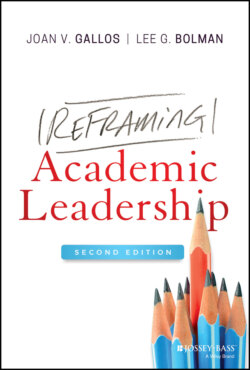Читать книгу Reframing Academic Leadership - Lee G. Bolman - Страница 16
Purpose of the Book
ОглавлениеReframing Academic Leadership is designed to serve all who labor doggedly in the academic trenches to bring quality teaching, research, and service to those who need it. It offers perspectives for understanding the unique dynamics of the academy as well as realistic and practical strategies to get the cats to follow, the jelly to stick, and the pea to move uphill – without too many scraped or bent noses. It was written to challenge readers to reflect on their experiences and to consider new ways of thinking and leading. You may already suspect that what got you here may not be enough to get you where you hope to go in the future.
Leadership preparation for higher education is of two kinds, and this book is written to offer both. One is intellectual – the acquisition of ideas and a conceptual roadmap, if you will, that help academic leaders see more clearly what they're up against and what options they have. Leadership sage and former university president Warren Bennis captured this mission simply when he noted: “When you understand, you know what to do” (Bennis, 2003, p. 55). Knowledge is power, and academic leaders empower themselves when they know where to go, what they are up against, and what they can do about it.
A second mode of preparation is more personal and behavioral. Leadership requires a moral compass and individual qualities like courage, confidence, agility, resourcefulness, and creativity – the foundations of healthy leadership resolve and stamina. We strengthen those qualities in ourselves when we compare our worldview with what others see and when we understand how the mindsets we have formed from our everyday experiences open us up or close us off to options and to new learning. Higher education cases that are sprinkled through the book offer opportunities to think about what you might have done – or done differently – in similar situations. Leadership success rests in the quality of the choices made by leaders, and leaders make better choices when they are mindful about their thought processes and actions. Research and experience tell us that academic leaders go awry for two principal reasons: (1) they see a limited or inaccurate picture – they miss or misread important cues and clues in their environment – and as a result take the wrong course; or (2) they fail to engage others and take people along with them – they move too fast, too unilaterally, or without full appreciation of the power of existing cultural norms and traditions to help or hinder buy‐in. The goal of this book is to reduce your risk of falling into similar traps by helping you expand the ideas and understandings that you bring to your work and the self‐awareness essential for using them effectively.
Our approach builds from multiple sources: our work as academic administrators, our teaching of higher education leadership to aspiring and seasoned professionals, our experience as students of organizations and leadership, and our own and others’ scholarship. We draw on ideas and concepts from a variety of sources, including seminal work on organizational learning (Argyris & Schön, 1992; Senge, 1990), professional effectiveness (Schön 1983, 1990), cognition (Bargh, 1994; Dane & Pratt, 2015; Gladwell, 2005; Groopman, 2007; Kahneman, 2011; Langer, 1989), and academic leadership (Birnbaum, 1992, 2001; McLaughlin, 1996; Padilla, 2005). Our perspectives are informed by a conceptual framework that has been important to our individual and collective work offered by Bolman and Deal (Bolman & Deal, 2021; Gallos, 2008), who argue that it is easier to understand colleges and universities when you learn to think of them simultaneously as machines, families, jungles, and theaters. Each of those images corresponds to a different frame or perspective that captures a distinctive slice of institutional life. The capacity to embrace multi‐frame thinking is at the core of the model of academic leadership effectiveness developed in this volume.
The image of the machine, for example, serves as a metaphor for the task‐related facets of organizations. Colleges and universities are rational systems requiring rules, roles, policies, lines of authority, and coordinating mechanisms that align with campus goals. Academic leaders succeed when they create an appropriate set of campus arrangements and reporting relationships that offer clarity to key constituents, coordinate the efforts of multiple people and units, and facilitate the work of faculty, students, staff, and volunteers.
